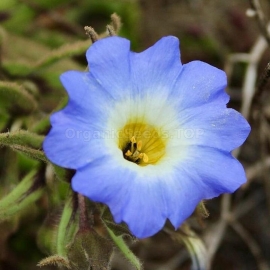


«Blue Bird» - Organic Nolana Seeds
1.14 €
Chilean Bellflower Blue Nolana Paradoxa is herbaceous succulent annual plant native to Chile and Peru. Chilean Bellflower Blue seeds can be started indoors in early spring or directly outdoors after last frost.
-
Organic Nolana «Blue Bird» / Nolana paradoxa
Chilean Bellflower Blue Nolana Paradoxa is herbaceous succulent annual plant native to Chile and Peru. Chilean Bellflower Blue seeds can be started indoors in early spring or directly outdoors after last frost.
The compact growing and trailing Nolana Paradoxa plant has succulent stems and hairy, ovate stalked leaves. This Chilean Bellflower blooms with large, trumpet-like, blue flowers with a white center and yellow throat. The hardy and drought tolerant Nolana Paradoxa blooms all summer long making a wonderful ground cover, container, window boxes, hanging basket, and rock garden plant.
How to Grow
Chilean Bellflower Blue Nolana Paradoxa is herbaceous succulent annual plant native to Chile and Peru. Chilean Bellflower Blue seeds can be started indoors in early spring or directly outdoors after last frost. The compact growing and trailing Nolana Paradoxa plant has succulent stems and hairy, ovate stalked leaves. This Chilean Bellflower blooms with large, trumpet-like, blue flowers with a white center and yellow throat.
The hardy and drought tolerant Nolana Paradoxa blooms all summer long making a wonderful ground cover, container, window boxes, hanging basket, and rock garden plant.Chilean bell flower, which isn’t widely available in nurseries and garden centers, is usually planted by seed. You can plant Chilean bell flower seeds directly outdoors after all danger of frost has passed in spring.
Although planting outdoors is preferred, you can also start the seeds indoors in peat pots five or six weeks before the last expected frost. Sprinkle the seeds lightly on the soil and cover them with about 1/8 inch of sand or soil. Thin the seedlings, allowing 4 to 8 inches between each plant, when they are 2 to 3 inches tall. The plant requires full sunlight and thrives in any well-drained soil, including sand, gravel and poor, dry soil.
